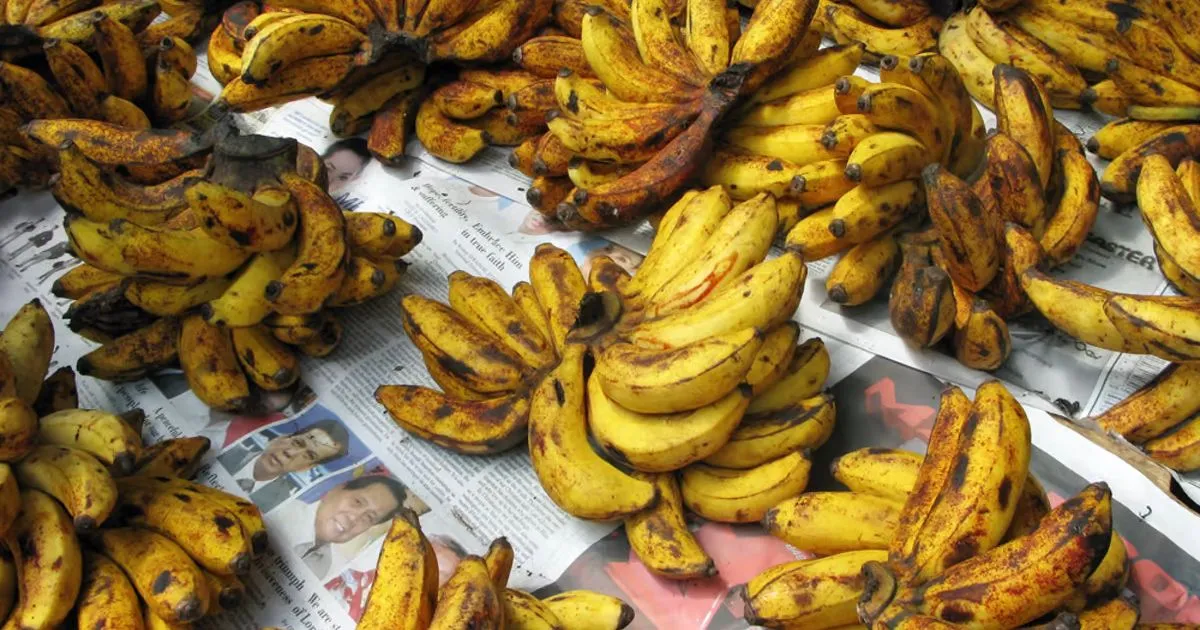
What is The New Bananageddon Fungus
A new fungus is causing big problems for bananas around the world. Scientists are calling it “Bananageddon.” This fungus is attacking the most common type of banana, called Cavendish. In the 1950s, a similar fungus killed off a different kind of banana. Now, experts are worried this could happen again. This shows how easily bananas can be harmed. We need to find new ways to protect different types of bananas and make sure we have enough food for everyone.
A type of fungus called TR4 is very dangerous for bananas, especially the most common kind. This fungus gets into banana plants through their roots and kills them. TR4 is different from older fungi that hurt bananas. It has special parts that make it very strong. When TR4 gets into the soil, it stays there for many years. This makes the soil useless for growing bananas for a long time.
Gros Michel Banana History
The Gros Michel banana, once the dominant commercial variety, fell victim to Fusarium wilt caused by Fusarium oxysporum race 1 in the mid-20th century. This devastating outbreak led to the variety’s functional extinction in commercial plantations, prompting the banana industry to seek a resistant alternative. The Cavendish banana, initially prized for its natural resistance to the race 1 fungus, emerged as the replacement and quickly became the new standard in global banana trade. This historical precedent underscores the vulnerability of monoculture crops and foreshadows the current challenges faced by the Cavendish variety against the TR4 strain.
Combating Banana Diseases
Scientists are developing innovative strategies to combat the TR4 fungus and protect banana crops. Researchers at the University of Massachusetts Amherst have identified key genes in the fungus linked to nitric oxide production, which appears to be crucial for its virulence. By removing these genes, they were able to significantly reduce the fungus’s ability to infect plants. Other approaches include:
Genetic engineering of Cavendish bananas to increase resistance
Exploring naturally resistant wild banana varieties for breeding programs
Developing soil treatments to reduce fungal spore viability
Implementing strict biosecurity measures in banana-producing countries
Additionally, companies like Elo Life Systems in Research Triangle Park are using gene editing techniques to create fungus-resistant Cavendish bananas, with field tests planned in Honduras. These efforts aim to preserve the world’s most popular fruit variety while ensuring long-term sustainability of banana production.
Economic and Nutritional Impacts
The potential extinction of Cavendish bananas could have far-reaching consequences, affecting both global economies and nutrition. Annually, nearly 100 million tons of bananas are produced in about 120 countries, with the industry facing fungicide costs of up to 35% of total production expenses. Nutritionally, bananas serve as a vital source of vitamins and fiber for millions worldwide, particularly in developing nations. The loss of this staple fruit could lead to significant dietary gaps and economic hardships for banana-dependent communities. To mitigate these risks, efforts are underway to diversify banana cultivation, with researchers and companies like Elo Life Systems partnering with major producers such as Dole to develop fungus-resistant varieties.
What are the environmental consequences of widespread fungicide use in banana farming
Biodiversity Decline
The reliance on monoculture farming systems, such as those used in banana production, contributes to habitat loss and a decline in biodiversity. This is exacerbated by the extensive use of synthetic pesticides, which disrupt local ecosystems and affect non-target species, including beneficial insects and aquatic life.
Soil and Water Contamination
Fungicides can lead to soil contamination, affecting soil health and microbial communities essential for nutrient cycling. Additionally, runoff from banana plantations can contaminate nearby water bodies, posing risks to aquatic ecosystems and drinking water sources. Studies have shown that pesticide concentrations are particularly high in aquatic systems, with detrimental effects on various species.
Resistance Development
The continuous application of fungicides can lead to the development of resistant strains of pathogens, making it increasingly difficult to manage diseases like Black Sigatoka. This resistance can result in a cycle of increased fungicide use, further harming the environment and potentially leading to more severe ecological imbalances.
Human Health Risks
The environmental impacts extend to human health, as pesticide exposure has been linked to various health issues, including cancers and neurobiological disorders, particularly among children living near banana plantations. This exposure is often a result of agricultural practices that do not adequately protect workers and nearby communities from pesticide drift and contamination.
Sustainable Alternatives
To mitigate these environmental consequences, there is a growing call for the adoption of sustainable farming practices, such as integrated pest management (IPM) and organic farming methods. These approaches aim to reduce reliance on chemical pesticides while maintaining productivity, ultimately benefiting both biodiversity and human health.
